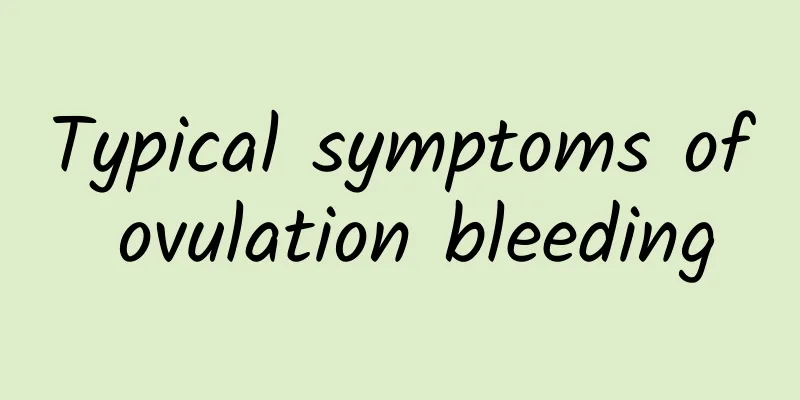Typical symptoms of ovulation bleeding

|
What are the typical symptoms of ovulation bleeding? The so-called ovulation bleeding, also known as mid-menstrual bleeding, refers to a small amount of bleeding between two normal menstrual periods, which usually occurs about 14 days before the onset of menstruation. The most obvious symptom of ovulation bleeding is uterine bleeding. Generally, the amount of bleeding is small, some are only brown secretions, and in very rare cases, it is a little bit, or there is blood in the bandage. Some bleeding lasts for several hours, or stops on its own after two to three days. The longest does not exceed seven days. In addition to a small amount of vaginal bleeding, ovulation bleeding is also accompanied by lower abdominal pain or backache, which is more common on one side and sometimes bilaterally, and can be mild or severe. It usually lasts for several hours, and in some patients it can last for 2 to 3 days. In addition, during the ovulation period, due to the secretion of progesterone, the body temperature rises slightly after ovulation. Generally, it is necessary to use a thermometer to detect it. However, although some women do not test their basal body temperature, they will feel a little hot half a month after ovulation, especially every afternoon. In addition, many women will experience breast swelling or nipple pain during ovulation, and sometimes they simply cannot touch the nipples. The breast symptoms may continue until the eve of the next menstrual period. In short, the above changes during ovulation exist in every sexually mature woman. However, some symptoms are obvious, while others are not, and you need to be careful to feel them. Ovulation bleeding is generally a normal physiological phenomenon. According to statistics, about 50% of women of childbearing age have experienced ovulation bleeding and ovulation abdominal pain. Female friends do not need to worry too much. As long as you pay attention to hygiene and diet, avoid excessive fatigue, and strengthen physical exercise, you can prevent and maintain health. But some people have more serious cases, and the bleeding may not stop until the next menstrual period. Or this phenomenon occurs almost every month, which requires sufficient attention. Repeated ovulation bleeding will affect the timing of conception, leading to infertility or even worse, it may be caused by certain diseases, such as cervical erosion, cervical polyps, cervical cancer, uterine submucosal fibroids, etc. Therefore, it is best to check in time and treat it in a targeted manner. Whether ovulation bleeding is associated with disease can be confirmed by diagnostic curettage, basal body temperature measurement (basal body temperature is biphasic, bleeding occurs when low and high temperatures change), and laparoscopy. |
<<: What are the causes of ovulation bleeding?
>>: How to identify ovulation bleeding
Recommend
Which diseases should vulvar leukoplakia be differentiated from?
What diseases should vulvar leukoplakia be differ...
Get rid of obesity during menopause ~ 2 powerful tools: strength training and aerobic exercise
Everyone ages, and once they enter menopause, mos...
In life, we should always do a good job in preventing ovarian cysts
Now, with the increasing number of patients with ...
Delayed menopause should alert ovarian tumors
Menopause is a dangerous period for women. During...
Modify the abdominal curve! Quickly learn the "Goldfish Slimming Exercise"
Effectively promote metabolism, muscle training m...
What are the changes in sex hormones in uterine fibroids? Is sex hormone high or low in uterine fibroids?
Uterine fibroids are a common gynecological disea...
Unbearable itching is a typical symptom of vulvar leukoplakia
Many female friends do not pay attention to hygie...
Learn 8 barley dishes to lose weight in autumn
1. Papaya, Tremella and Coix Seed Soup Ingredient...
What are the causes of cervicitis? What are the hazards of cervicitis in women?
What causes cervicitis? Formal abortion surgery A...
How to cure Bartholinitis
In my country, the incidence of Bartholinitis is ...
Massage alone is not enough! To solve constipation and fat belly, grapefruit essential oil is more effective
Constipation not only easily accumulates stool, l...
Four common advantages of painless abortion
Nowadays, many female friends will choose painles...
Why does menstruation not come after medical abortion? It may be due to the following two reasons
Medical abortion has been widely used in clinic i...
How to treat cervicitis and cervical hypertrophy completely
Cervicitis and cervical hypertrophy are generally...
Will chronic cervicitis cause bleeding in women? Check out some common symptoms of chronic cervicitis
The treatment of chronic cervicitis is relatively...









